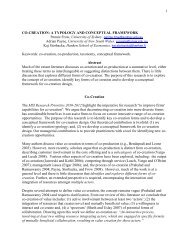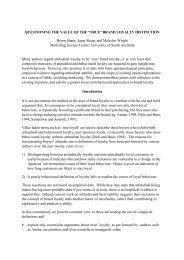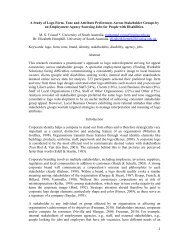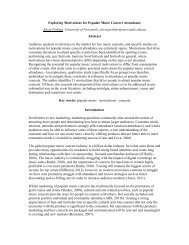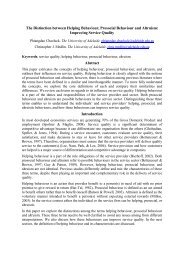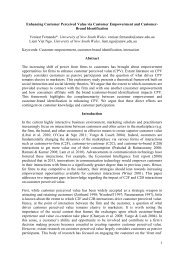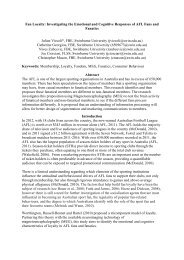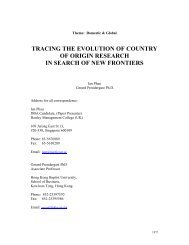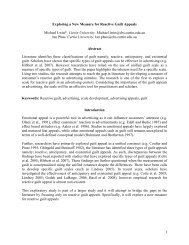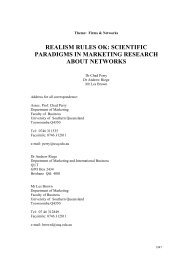UNDERSTANDING CONSUMER INTENTIONS TO ... - ANZMAC
UNDERSTANDING CONSUMER INTENTIONS TO ... - ANZMAC
UNDERSTANDING CONSUMER INTENTIONS TO ... - ANZMAC
You also want an ePaper? Increase the reach of your titles
YUMPU automatically turns print PDFs into web optimized ePapers that Google loves.
The study was conducted in a field setting using survey methodology. A web-based<br />
questionnaire was used to collect data. Development of the scales to measure each of the<br />
constructs in the model proceeded through a series of steps, based on the procedures suggested<br />
by Ajzen and Fishbein (1980) and Ajzen (1985, 1991). The questionnaire was then subjected to<br />
two rounds of pretesting on the web prior to sending out the final instrument.<br />
Results<br />
A total of 956 e-mail letters were sent to staff at a New Zealand university and local research<br />
organisations. From this sample pool, 323 useable responses were received, for an effective<br />
response rate of 34%. Before commencing analysis of the theoretical models, all variables were<br />
examined for reliability, validity and normality, and were deemed adequate for further analysis.<br />
Each of the two models presented above was then subjected to path analysis testing, using<br />
AMOS 3.6 software for structural equation modeling. A path analysis approach was used<br />
because all variables were manifest rather than latent. Introducing latent variables in addition to<br />
the manifest variables would have required a larger sample size.<br />
The data did not prove to be a good fit for the proposed TRA model. The best model, achieved<br />
had a Chi square of 160.12, 11df. Although 41% of the variance in carpool behavioural intention<br />
was explained in the model, the root mean square error of .21, p=.00 indicated the poor fit of the<br />
model to the data.<br />
Carpooling intentions were better explained when the data were tested using the TPB model.<br />
However, the model did not fit exactly as hypothesised. The best fitting model, presented in Figure<br />
3, achieved a Chi square of 14.95, 5df, with a rmsea of .08, p=.13.<br />
SRA<br />
PRA<br />
COMPAT<br />
EXPER<br />
INT_NORM<br />
.18<br />
.23<br />
.30<br />
.22<br />
0, 1<br />
err1<br />
.78<br />
.40<br />
ATTITUDE<br />
.13<br />
.20<br />
SUBNORM<br />
.37<br />
0, 1<br />
Err4<br />
.70<br />
.50<br />
INTENT<br />
Hypothesised<br />
relationship (not<br />
significant)<br />
Hypothesised<br />
relationship<br />
(significant at p ≤ .05)<br />
Significant<br />
relationship (p ≤ .05),<br />
not hypothesised<br />
Significant covariance<br />
relationship (p ≤ .05)<br />
EXT_NORM<br />
FAC_RES<br />
SELF_EFF<br />
.40<br />
.19<br />
Err2<br />
0, 1<br />
PB_CONT<br />
.87 0, 1<br />
Err3<br />
.25<br />
.29<br />
Chi square = 14.95<br />
df = 5 p = .01<br />
cmindf = 2.99<br />
rmsea = .08<br />
p of close fit = .13<br />
Figure 3. Carpooling Behaviour as Explained by the Theory of Planned Behaviour




